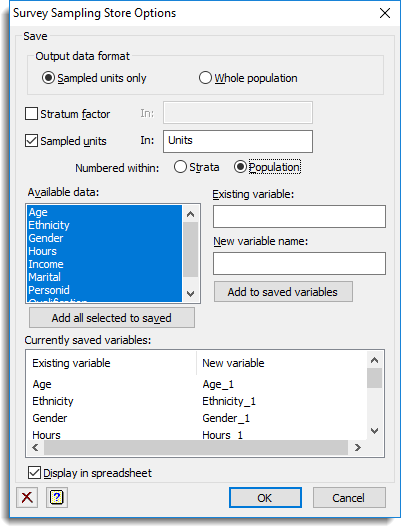Use this to save results from the Survey Sampling menu in Genstat data structures.
- After selecting the appropriate boxes, type the identifiers of the data structures into the corresponding In: fields. or set up the Currently saved variables list.

Output data format
This option controls how the sampled units are indicated:
| Sampled units only | Save the unit numbers of the sampled units. |
| Whole population | Save an indicator for the whole population, with 1 for sampled units and 0 otherwise. |
Save
The available save options of the survey sample:
| Stratum factor | Factor | Saves the stratification factor which indicates which stratum the sample unit belongs to. |
| Sampled units | Variate | Saves the sample units, according to the Output data format setting. The Numbered within option controls how the units are numbered. |
Numbered within
| Strata | The numbering starts again from 1 in each stratum. |
| Population | The numbering continues upward from 1 through the whole population. |
Available data
This lists the structures that are available for selection that match the expected type of the current edit field (either Existing variable or New variable name – although most likely this field will need to be typed as these structures are unlikely to already exist). Double-clicking an identifier name will copy the it into the edit field with current focus and then move focus to the next edit field.
Existing variable
This gives the name of a structure (variate, text or factor) defined for the whole population that is to be reduced to just the sample units only and saved in the new structure specified by the New variable name. This can be entered by typing in the name or by double-clicking a name in the Available data list. An automatic entry is created in the New variable name, which uses the old name, but changes the case of the first letter, and then makes sure it is unique. You can edit the new name before adding it if you want an alternative name for the saved variable for the sample.
New variable name
For the variable in the Existing variable field, this gives the name of the structure that will contain this structure’s data for the selected sample. When you have defined both the Existing variable and New variable name, use the Add to saved variables button to add it to the Currently saved variables list.
Add to saved variables / Update saved variable
Add the current Existing variable and New variable name into the Currently saved variables list. Only a single instance of the variable names can be added to the currently saved variables list. If the Existing variable name is present in the list then the button will display the title: Update saved variable. In this case, using this button on an existing variable present in the list will replace the associated New variable name.
Add all selected to saved
Add all the selected items in the Available data list into the Currently saved variables list using default names for the New variables.
Currently saved variables
This lists the pairs of Existing variable and New variable name that will be saved. Double click on an item to edit the New variable name. A right-mouse click on an item in the list opens a shortcut menu where you can choose to edit the New variable name and delete selected or all items from the list.
Display in spreadsheet
Select this to display the results in a new spreadsheet window.
Action Icons
| Clear | Clear all fields and list boxes. | |
| Help | Open the Help topic for this dialog. |
See also
- Survey Sampling menu.
- Options dialog for specifying options.
- SVSAMPLE procedure.